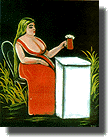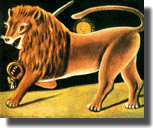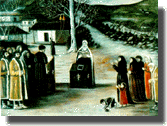Pirosmani and Georgian society
Portraits

Georgian Woman with a Tambourine
Childless Millionaire and a Poor Woman Blessed with CHildren
Pictures of Animals

A Deer Family. 1917
Scenes of Rural Life

Landscapes


Niko Pirosmani
Short Biographical Information.
Niko Pirosmani is what Georgians are proud about, he was self educated artist, who invented new painting technique not only thanks to his great talent but also out of poverty. He is one of the outstanding primitivism painters in the World. But as it usually happenes to greatests - he lived and died in poverty, never recognized by his countrymen while he was alive.
Land of birth, Family and Childhood.
Niko Pirosmani (Pirosmanashvili) was from the east part of Georgia -- Kakheti, where live the most even-tempered and calm Georgians. They grow grapes and Kakheti is considered to be the motherland of the best Georgian wine.
Niko Pirosmani was born in 1862, possibly in May 5. His parents - Aslan Pirosmanashvili and Tekle Toklikishvili were farmers. They had couple of cows and oxes, the little vineyard, and were not poor and nor rich. His father was big fairy-tale admirer, and both they worked hard were devoted to the family and were happy together. They had three children, two daughters - Mariam and Pepe and the youngest Niko.
But in 1870 his father caught cold and died, so their short term family happiness ended there. That happiness and love to his relatives is obvious from his pictures - on painting "Rtveli - Picking Grapes", you see a woman and a man, possibly that is how his parents were - working all the time, or painting "Mother and Son" could be only inspired with his sweet dream about mother, and similar "Father and Son". Child on both of these pictures is obviously the same. But with the death of his father that idle and happy life ends and in his paintings start to penetrate more dark and gloomy colors, children are sad, and women pictured on them is bent under the pressure of hard work. On the picture "Georgian Women With Children" a woman holds on a heavy jar of water on her back, little girl and boy, who stops on each step and looks behind, women tries to hold him and keep his pace. Niko was nice boy, he worked from early childhood to help his mother as much as he could.
Niko painted his sister Mariam, her husband bought her an umbrella and nice hat - "A Woman With Flower and An Umbrella". When he was 8 Mariam's husband took him to Tbilisi to ease his mother's life and keep company for his sister, he had good life there with Mariam, but soon she got seek during epidemic of cholera in Tbilisi and died. Her husband didn't care much about child and he gave him to Kalantarov's family to live with them and serve them at the table.
In that family Niko was loved and treated well. His duties were to boil 'samovar' (a big pot to boil the water), bring water and wash the dishes. Niko learned to read and write in that home, he was smart boy, he loved to read books and paint, he painted all the walls in his room. Already from his childhood he didn't care about material things, he was all in the creative work. They loved him in that family, he was devoted and honest, and they would trust him everything. Also he had very good gift of declamation, and often diverted children from the neighborhood with fairy tales, painting in the same time on the walls what he was telling.
Later he lived in another family, working there as a servant as well. He was treated well there too. When he became young man he fall in love with his land-lady - Elizabeth (she was widow). Possibly she was fond of him too, but she kept that secret, that was not satisfactory for Niko, he wanted to marry her. According memoirs of Solomon - Elizabeth's son Niko wrote her letter asking to marry him - "I'm well aware that there is a big gap between us and our positions, but I know that you are prominent and educated woman and I hope you won't pay that much attention and will accept my proposal. I assure you - my love to you is the most sincere and dearest." But soon everybody get to know about their love affair and he had to leave Elizabeth's house. After that he started independent life.
Margarita, where the legend comes from.
One of Pirosmani's pictures presents a young woman, and is signed -- "Actress Margarita". She was an inspiration for many romantic legends and poems.
It is known that Margarita was french dancer. She came to Georgia in 1905 and met Niko Pirosmani. He was so charmed with her beauty, that gave her literally the sea of flowers. This story became widely known during his life and it reached the writer Shalva Dadiani. In 1922 some Simon Papiashvili wrote about him: "He has no family. One french woman loved him, I guess, whole year..." Niko's sister -- Pepe wrote to Dadiani: "He never had family, but I know for sure he had a lover."
Who was that woman, whom Niko loved and whom he made immortal on his canvas? There is almost nothing known about this.
An admirer of the painter's talent, K. Zdanevich described this story in his book with following words: "Niko didn't know what is love before he met singer-dancer in cafe-shaitan. In Mushtaid Garden, on lightened stage, accompanied with sounds of mazurka beautiful and alluring madam Margarita appeared before of amazed public, she was dancing and singing charming and cheerful Paris songs... Niko couldn't stop gazing at her, he was captivated."
Niko's happiness didn't have any boundaries, all he spared during his whole life he spent for her, for the woman he loved. But Margarita got to know one day that he wasn't count and he wasn't rich and he was just common person who gave her all he had... and once Niko found out that Margarita left for Paris.
Konstantin Paustovskii described the story of that love in his book: "The carts were full of flowers up till edges, with drops of water, seemed like the early-dew sprinkled them with billions of rainbow drops.
The carts stopped at Margarita's house. Carters talked awhile with each other in low voices, and then started to unload the carts and throw flowers on the ground in front of gates, covering stones in pavement and road. Yes, these were thousands of flowers that Niko got for his beloved woman."
After these events, that he had bad luck in trade, and that he lost all his sparing, and lost his workshop, Pirosmani never reestablished it. From now he started to wonder around, visit "dukhans" -- old Tbilisi restaurants -- trying to find place and paint there.
People from different levels of society used to come to that "dukhans", used to spend there a lot of time eating, chatting and having also business discussions.
Niko watched these people, their habits, behavior and painted all that he had seen, he painted his country's life, it's history, it's beauty. Then he put his artworks in dukhans and people saw them and used to discuss them. They liked his works: "Tamar" (the famous queen in 12th century), "Rustaveli" (old writer), "Giorgi Saakadze" (historic figure), "Erekle the Second" (legendary king) and many other. Niko was happy that he had chance to let out his passion of creativity on the canvas which people could see. But these people, who saw his works in "dukhans" couldn't properly value his artworks and he was known as homeless and drinker. Some merchants took advantage of him, others were nice and kind.
Ilia Zdanevich visited Pirosmani in 1913 and Niko shortly described his life: "I am poor... My clients are not educated". He didn't have place to live, and had found place to stay in dark and damp vine store, but he was too proud to ask "dukhan" owner to give him place better. Zdanevich noticed in his notes that these owners frequently disturbed Niko from his work and didn't leave him alone.
Discovering Pirosmani.
The 19th century was coming to its end, that was the period of important political events as well as the period of flourishing of Georgian culture, many famous and talented people were working at that time, such as writers and poets Ilia Chavchavadze - who was murdered for his prominent political views, Akaki Tsereteli, Vaja Pshavela - poet and writer in love with the nature, Iakob Gogebashvili - who wrote the first manual book of Georgian language - "Ai Ia". And many others. At that time Georgia was under Russian rule, and all these prominent people were reflecting this hardship in their masterpieces.
The beginning of 20th century. Niko year after year is working in Dukhans. He lives in the little apartment not far from train station. All little enterprises in this neighborhood is filled with his paintings. They pictured Georgia, its beautiful land and sky, Georgian people, their everyday life. Also there are scenes from the past of Georgia, wonderful queen Tamara, brilliant Shota (12 century great poet), Heros and Heroines - real people, but by their deeds talked about like a saint.
He pictures kings and peasants, town and country, parties and prayers, dancers and singers, people and animals.
People were seeing these pictures, they were liked and prised, they were talked about. Michael le-Dantiu, Ilia Zhdanevich and his brother wrote about them in his memoirs. They also wrote that painter himself was very poor and struggled every day to earn living, as well as the materials for his art.
All kinds of people tried to interfere in his work, these were his clients - Dukhan-owners, thinking that they know better what he should paint, who usually payed him only with food, while he was working in their dukhans. Zhdanevich wrote about Pirosmani letter to editors of a newspaper "Zakavkazskaia Rech'", and they published it in February 13, 1913. He also promised to take his paintings: portrait of himself and Roe to Moscow, and make society aware of such a great painter. Moscow newspaper "Moskovskaia Gazeta" of January 7, wrote about exhibition "Mishen'" where self educated painters had their artworks, among them Niko Pirosmanashvili was presented with his 4 paintings: "Zhdanevich's Portrait", "Still Life", "Woman with the Beer Mug", and "The Roe". And critics which were published later in the same newspaper were impressed with his talent.
Seemed like the ice is broken, and Pirosmani is discovered. People showed some interest to him and his work. But nobody actually helped him, he kept living in poverty, among impudent and irritating dukhan-owners and arrogant clientele.
Niko and Georgian society.
First article about Niko Pirosmani and his art was published in Georgian newspaper "Temi" as early as 1913, but Georgian society still knew very little about him.
First who showed interest in artist's fate among Georgians was Dito Shevardnadze. He arrived in Georgia in 1916, and he immediately noticed paintings which were decorating dukhans nearby Tbilisi rail station. At that year he had an idea to make a connection between all Georgian artists and for that reason found the society. He created list of artists, and among them was Niko Pirosmani too, he was granted the title - "national artist".
The first meeting of that society took place in March 1916, and in papers about that meeting is some notes about Niko:
"Issue about finding and buying paintings by Niko Pirosmani, finding out his address and information about him. The chair thinks it is important to be serious about his artworks, there is need to find them and to get them. Since the Society doesn't have sufficient funds, it should address Georgian Historical-Ethnographical Society, and seek it's help, ask them to get these paintings because they are national treasures. The goal of Society is to help find and get those paintings and organize their exhibition.
Society should find out where is Niko Pirosmani, whether he is alive, or need some help. Some work should be done to find out his biographical information. All these work should be done by specially created committee. Members of that committee are Lado Gudiashvili, Ioseb Gogolashvili, Mose Toidze and Gigo Zaziashvili".
It is obvious that Georgian public didn't' know at that time whereabouts of Niko Pirosmani. After some time Mose Toidze and Gigo Zaziashvili found him in May 24. And this was published in newspaper "Narodnyi Listok". They invited Niko on next meeting of the society of painters.
After meeting was over Niko met Shevardnadze, talked to him and was very happy that they showed interest to his art and himself. They gave him 10 rubles and made his picture. He bought painting material with that money and painted on very big canvas "Utsindeli sakartvelos kortsili" - Wedding in Georgia of the past times. He presented this painting to the Society.
Seemed like things are going well and he would get some help. But the month didn't even pass and in newspaper some G.Z. (Gigo Zaziashvili) published cartoon: very old man with palette in his one hand is painting a Giraffe. Next to him is standing Grigol Robakidze (modern writer) who is saying - "You must learn, brother! Man of your age can still crate a lot... after some 10-20 years you will grow to be a good painter... And then we will send you on young artists exhibition..."
This was very painful for Niko. After that he stopped all his contacts with that Society. The bridge between Niko and rest of Georgian painters was broken. He was left again among dukhan people. The First World War started at that time, so situation got worse, there was no clientele, and he was weak because of poor health. He lived near Malakan Bazaar under the stairs room, but after some time, because he couldn't pay the owner throwed him out. Niko knew that the basement of that house was empty and used to go there after dark. But once, in the end of winter he went down there being already sick, and couldn't get up in the morning. After couple days one of the neighbors found him there unconscious, he called help and Ilia Mgaloblishvili put him in the hospital, but it was already late, he died after few hours. This was 1918, night before Easter.
Created by Steele Communications
Special thanks to Ms. Nino Chikobava for her kind help in gathering of information.